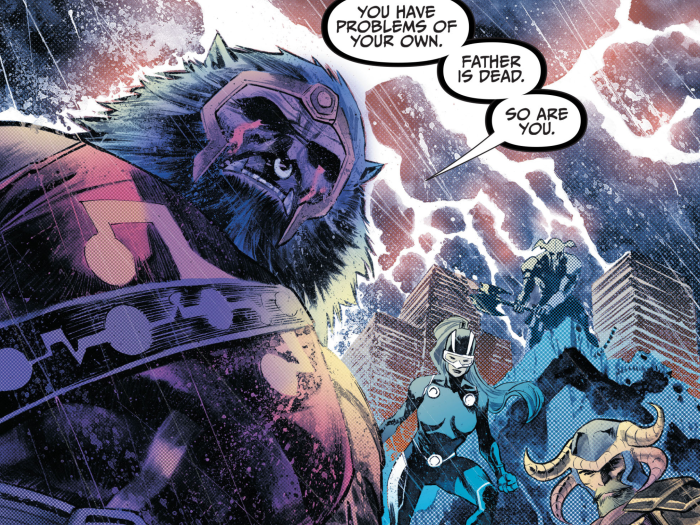Justice League #45 is an issue that should have been delayed. Whereas Jason Fabok, currently the series’ main artist, has drawn every issue in The Darksied War so far, and according to solicitations will finish the remainder of the arc from #47 onward, this issue and the next mark a drastic artist shift, one which is incongruent with the rest of the series.
None of which is to say the art is bad, per se. But despite Justice League being a monthly series and not an event, The Darkseid War is for all intents and purposes DC’s latest Crisis. Books such as Crisis on Infinite Earths and Final Crisis are part of a proud legacy marked by immense consequences and superb storytelling. There can be little doubt that DC intends for the trade of The Darkseid War to enjoy a prominent place on bookshelves right alongside such classics. And to their credit, thus far Johns has been penning an epic which writers will reference and readers will reread thirty years hence, as they still do with Wolfman and Perez’s influential maxiseries.
Which is why DC’s rush to release Justice League on a regular monthly schedule, even at the cost of bringing on a fill-in artist, is both baffling and supremely disappointing. The Vertigo branch of the company understands the virtue of patience and the value of delays to produce a superior final product. Their recent Sandman: Overture took twenty-three months to deliver its five issues. Worth it. A single page without J.H. Williams’ sublime art would be utterly inconceivable.
Even their competitor, Marvel, demonstrated willingness to delay its own continuity shattering crisis, Secret Wars, with the final issues now being published after the consequences have begun to play out in the various issue #1s of their relaunch. They too deemed it of greater importance for the trade to benefit from the consistency of Esad Ribić’s art for decades to come than preventing spoilers or confusion for a few brief months.
A final word on the matter: Justice League, while canonical to DC’s current continuity and taking place somewhere on the same timeline as the other books in the publisher’s catalogue, is entirely self contained. It directly references no other books, and no other books directly reference it. Only Justice League at the moment contains Bruce Wayne under the cowl of the bat and a fully powered Superman whose secret identity remains unknown to the world. A two month delay on this book would have affected nothing else whatsoever.
With that said, the issue on it’s own is a bit of a mixed bag. Following the climactic battle of the previous issue, itself the culmination of The Darkseid War: Part 1, this issue starts surprisingly slow. Instead of dealing directly with the Anti-Monitor’s victory over Darkseid, the former’s entire army immediately vanishes, leaving a quite calm for the league members to deliver expository dialogue. The pace quickly ramps back up, however, with the major theme in Part 2 being established throughout the remaining pages: apotheosis.
While Part 1 saw a few of the characters ascend to godhood, by the issue’s end such is the status quo for nearly every member of the team, with their specific roles in the new pantheon being explicitly spelled out: Superman is the god of strength. Batman the god of knowledge. Wonder Woman the goddess of war. Flash the god of death. By far the best reveals were Shazam and Lex Luthor; the former is the god of gods, and the latter, it is heavily implied, is the god of evil, the new Darkseid.
While the metaphor of a modern pantheon has often been ascribed to superheroes in general and the Justice League in particular, apart from Wonder Woman such “godhood” has rarely been explicitly true within the comics themselves. Fan’s might have jokingly referred to Morrison’s perfectly prepared Caped Crusader as “Bat-god,” but Johns here has bestowed upon him actual omniscience.
Manupul’s art delivers some interesting camera shots; one splash of Kalibak and Steppenwolf channels the imposing pomp of an Alex Ross piece, and serves as a great argument for Manapul to get his own Fourth World series to draw. But otherwise his art in this issue tends to lean too heavily into cross-hatching and not enough in backgrounds, almost all of which are blank.
His and Buccellato’s colors, on the other hand, are the best part of this issue. Like Warhol and Laura Allred, they employee in places a pointillist style which evokes the four-color printing process of early comics. This is used in tandem with bright, bold water-colors which bleed into each other to achieve beautiful gradients.
Fabok’s hyper-detailed style would still be preferable, not just for consistency’s sake but because it better captures the popcorn superhero blockbuster which Johns is writing. Nevertheless, this is still a good issue in a great series in the middle of its most outstanding arc. It’s not to be missed.
7.0/10



